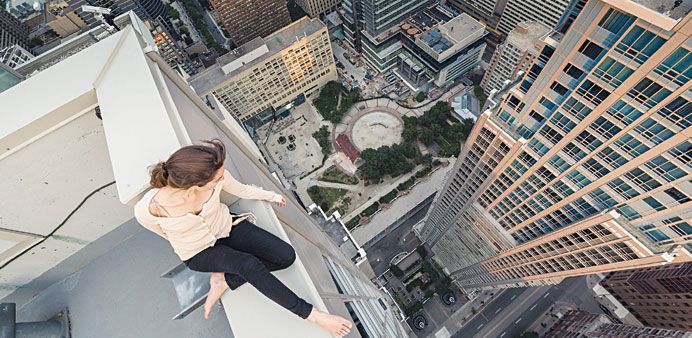By Bradley L Garrett/London
Last October, at the height of the umbrella movement in Hong Kong, a YouTube video was posted that went viral. In it, four masked ‘rooftoppers’ hijacked the feed of the enormous LED screen on top of the 52-storey China Online Centre by splicing into the control panel with a laptop. They looped on to the enormous screen a spine-chilling video of the same individuals climbing the under-construction Shanghai Tower in Beijing over a sea of early-morning fog, then filmed themselves watching the illegal screening from a drone.
The spectacle concluded, we follow the masked men as they jet down the stairs of the China Online Centre, change clothes in the stairwell and calmly walk out of the lobby like a scene from Mission Impossible.
Vadim Makharov and Vitaly Raskalov, the orchestrators of this meta-selfie, are part of a loose network of people who used to be called urban explorers. But the practice of urban exploration has now splintered under the weight of relentless media attention, crackdowns by authorities and attempts at marketing exploitation - reforming along divergent lines.
One of those lines is ‘rooftopping’, a practice of accessing rooftops to take dizzying skyline photography, often peppered with symbolic political messages and displays of bravado imported from parkour. Many will have encountered the Channel 4 documentary Don’t Look Down, featuring James Kingston, a free-runner turned explorer, who can be seen all over the Internet hanging one-handed from construction cranes and doing somersaults in precarious places.
Rooftopping, or ‘buildering’ as yet another variant is called, is nothing new. A 1937 book called The Night Climbers of Cambridge was full of photographs of agile young men (exclusively) climbing up drainpipes, over fences and balancing atop the spires of the old colleges.
In recent years rooftopping has spiked in popularity, attracting a more diverse set of practitioners. As an ethnographer who has studied urban exploration cultures around the world since 2008, each day I awake to new sets of click-bait assemblages with titles such as The 10 Most Death-Defying Rooftopping Photos or Heart-stopping Pictures of Daredevils Risking Their Lives trending in my social media feeds.
This bloated exposure was recently ruptured by three events in rapid succession. First, the pseudonymous climber Mustang Wanted repainted a Soviet star on one of Moscow’s Stalin-era Seven Sisters skyscrapers in Ukrainian colours and topped it with a flag, to the delight of Pussy Riot. Soon after, I got a message from a rooftopper in New York City telling me that the whole scene there was on lockdown after two German artists, Mischa Leinkauf and Matthias Wermke, put white flags on the Brooklyn Bridge and that the FBI were dragging urban explorers in for questioning. Finally, three explorers were arrested recently in Toronto, arguably the most historically relaxed city for rooftopping, and are headed to court to answer multiple charges including breaking and entering, and “mischief”.
It is clear that rooftoppers have been taking increasing physical and legal risks in recent years. Adrian Chen, in an article on the Outlaw Instagrammers of New York City, argues that younger generations of rooftoppers see the practice as a quick way to Internet stardom.
Relative newcomers to the scene can amass hundreds of thousands of followers in mere months by posting photos of their dirty sneakers dangling off buildings or, even better, photos of themselves dangling off buildings. Not long before before the Toronto arrests, a well-respected local explorer, Neil Ta, announced he was retiring from rooftopping precisely because of this behaviour:
That precarity has extended to the legal landscape, where harsher sentences are being handed down with each arrest. As much as I might agree with Neil, I do not think the search for fame sufficiently explains why people seem to want to take ever greater risks. After all, rooftoppers ‘get up’ in Dubai, Hong Kong, Moscow and New York, where the consequences of being caught are much more severe than in Toronto or Paris, for instance. If their missions were just about fame, surely the risk/reward ratio would tip the scales to places where they are less likely to end up in court or prison.
A second theory is that the escalation is coming from certain rooftoppers using the practice as a pathway into political activism - and the Hong Kong hijack and the Moscow star stunt certainly indicate this may be the case. After the China Online Centre hack, Vadim and Vitaly told Euan McKirdy at CNN that they have no philosophy, but reading a little deeper into the event does not take much effort. Only a five-minute cab ride from the skyscraper, a heaving crowd of thousands of pro-democracy protesters stood outside the Central Government Offices calling out “Beijing” and asserting their rights to the city.
There is also a third explanation, however: that exploration is inevitable. When you put people in cities where there is little available to explore on their own terms, activities like rooftopping are bound to take place - as is the escalation of those activities as people press up against the boundaries of freedom.
It turns out that a good deal of attention has been paid to these kinds of behaviours by psychologists and sociologists. Psychologists have tried to quantify what they call Type T behaviour (the T stands for thrill-seeking). In the words of researchers Kari Knutson and Frank Farley, these people” prefer high levels of stimulation, complexity, and are distinguished by flexibility in thinking styles “. The authors go on to suggest that Type T people not only comprise 25% of the population, but that there is a higher percentage of people who are risk-seeking than risk adverse .
Why, then, do we create risk adverse cities when this goes against majority desires? The foreseeable follow-up question is this: what does living in risk-adverse cities do to Type T people? Turning to sociology might provide an answer. Stephen Lyng worked with people undertaking what he called ‘edgework’ (a term coined by Hunter S Thompson); activities where individuals placed themselves in unnecessarily risky situations, close to the edge of death and chaos. Lyng goes further than Knutson and Farley to suggest that as people feel increasingly disempowered, edgework activities actually increase. Lyng’s study seems to suggest that the escalation we are experiencing in rooftopping activities is as much about our environment as it is about personal needs and desires.
Trying to separate these three motivations makes less sense than combining them. Recognition, politics and desire make for a pretty convincing motivational cocktail. The more people’s conversations are eavesdropped, movements curtailed and houses raided, the more they feel a need to push back. This arms race did not begin with urban exploration. It began when our rights to the city began to be stripped back and when curiosity - a natural and necessary inclination - became criminalised.
This is not armchair speculation: I have always been a Type T personality. I cave, I Scuba-dive, I skydive, I trespass and I work too hard … like most other T Types. In response to my explorations in the UK (part of my doctoral research), the police have raided my house twice and I have been on bail for most of the past three years under various charges.
But just being charged is massively disruptive to one’s life, which I think is the point. The Home Office has held my US passport almost constantly since August 2012, and I have spent much of my time living here with my possessions in police storage facilities. I have turned to publishing as a productive outlet, but I am filled with a frustration that no amount of crane-dangling will ever quell.
Rooftoppers may have trouble articulating their motivations, but the message comes through loud and clear in their photography - they want to be free to make choices to explore their cities, and the more those choices diminish, the more militant their reactions become.
Arresting and charging people does not stop rooftopping. Changing security protocols is unlikely to either - explorers have vaulted incredibly complicated security measures, including those at the new World Trade Center in New York.
The answer, it seems to me, lays in paying attention to the research and in coming to terms with the fact that a segment of every urban population needs to take risks to be content. Or, more accurately, a segment of every urban population needs to feel that they have agency, some sense of control over their lives.
While no one would recommend inexperienced climbers tackle skyscrapers, perhaps we should just let rooftoppers take the risks they want to take. If we can take off our health-and-safety blinkers for a moment, we may also realise that the photos, videos and stories produced by rooftoppers - many of them highly experienced adventurers - make the city a richer place to live.
Perhaps, too, it is time for us to all be honest with ourselves - we enjoy living vicariously through these thrill seekers. As Will Self has argued, let us reinstate the freedom to explore. - Guardian News & Media
- Bradley L Garrett is cultural geographer at the University of Southampton and the author of Explore Everything: Place-hacking the City and Subterranean London: Cracking the Capital . He is currently compiling a new book on rooftopping in London for release by Prestel Publishing next year.



